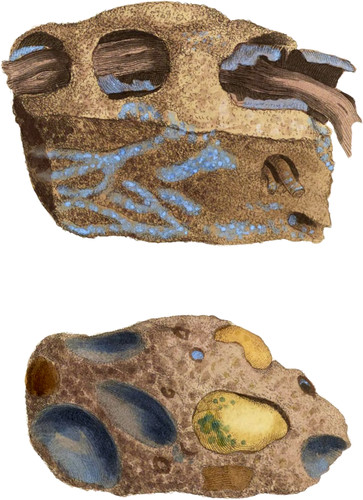 Enlarge
Enlarge
British Mineralogy
Azure Iron Ore
- Class 3. Metals.
- Order 1. Ductile.
- Gen. 8. Iron.
- Spec. 7. Azure Iron Ore.
- Spec. Char. Contains sulphur? and iron.
- Syn.
- Blue martial earth. Kir. v. 2. 185.
- Bluau eisenerde. Emmerling, v. 1. 359.
- Fer azuré. Haüy, v. 4. 119.
This is very common in marshy grounds at different depths in most parts of the United Kingdom.
The upper figure represents some as found at Blackwall, or the Isle of Dogs, where great abundance was met with about four feet deep, in a sandy loam, mixed with roots and other vegetable remains. At the depth of about nine feet, in some places, it was mixed with a black clay, turf, leaves, hazel-nuts, &c. It occasionally exists among earth with the remains of shells, and is common in marshy places without any appearance of vegetable. I found some once on the shell of the Mytilus anatinus in Hyde-park, and have had it sent me from Scotland.
The lower figure represents it as found near Kennington and Lambeth, where it is common about a foot under the roads in a dirty gravelly soil, partly hardened and approaching to what is commonly called pudding-stone. It adheres to the pebbles, but more particularly to the hollows where they have been. In endeavouring to ascertain the nature of this substance, we exposed some of the purest of the first sort to a gentle heat, which soon deprived it of the blue tint, emitting a sulphureous exhaltation, with a blueish flame, and left a dark ochry brown substance, which proved to be an oxid of iron. We could not detect any prussic acid by the usual method.
Mr. Kirwan says, its colour, in its native situation, when not exposed, is white. This may sometimes be the case, but ours was blue even when fresh gathered and first broken.
Lustre none. Fracture dusty, of the upper figure; earthy and compact in the lower. Water does not change the colour; oil darkens it.
Klaproth thought this mineral contained phosphorous, but Mr. Kirwan thinks “the inflammability of this substance must proceed from some other principle, most probably carbon, perhaps an astringent substance.”

